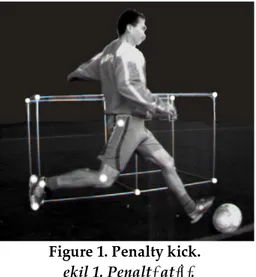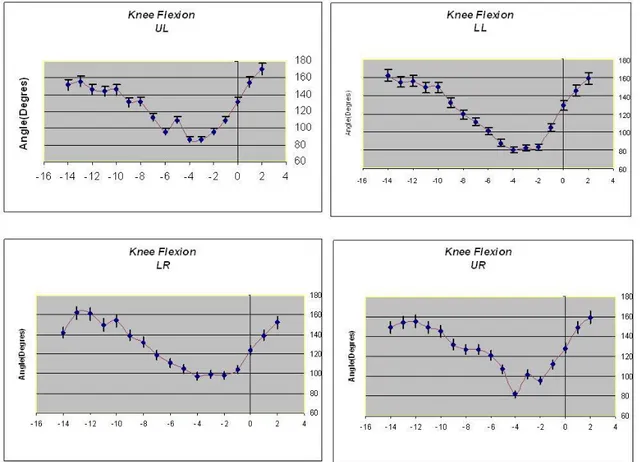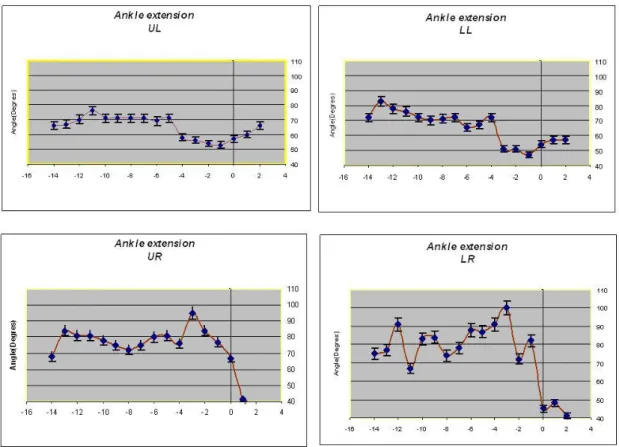KINEMATIC ANALYSIS OF PENALTY KICK IN SOCCER
1Ayhan GOKTEPE,2Hakan KARABORK,3Emre AK,3Seref CICEK, 3Feza KORKUSUZ
1Selcuk University, Technical Science College, Konya
2Selcuk University, Faculty of Engineering and Architecture, Department of Geodesy and
Photogrammetry, Konya
3Middle East Technical University, Faculty of Education, Department of Physical Education and Sport,
Ankara
ABSTRACT: Kinematics of the instep penalty kick to four different targets (50cm2) placed at the
upper left (UL), lower left (LL), upper right (UR), and lower right (LR) corners in the goal. Five colligate male soccer players were examined for their knee flexion and ankle extension strategies. The swing, ball contact and follow through phases were analyzed by using a dual camera and Pictran software system. Results revealed that participants had significantly higher ankle extension while hitting the target at the UR (m=77.6 deg, sd=10.5) and LR (m=84.4 degree, sd=10.1) corners. In conclusion players presented similar knee flexion but not ankle extension kinematic strategies at the contact and follow through phases of the instep penalty kick to different corners in the goal.
Keywords: Digital photogrammetry, kinematics, motion analysis, penalty kick. Futbolda Penalt At n Kinematik Analizi
ÖZET: Futbolda penalt at , kalenin sa üst, sa alt, sol üst ve sol alt kö lerine 50 cm büyüklü ünde bir hedef konularak gerçekle tirilmi tir. 5 adet sporcunun topa vuru s ras nda diz ve ayak bile inde olu an aç lar kinematik olarak incelenmi tir. Haretketin ba lang ç an ndan itibaren topa vuru an na kadar olan görüntüleri çift kamera ile çekilmi tir. Çekilen görüntüler Pictran fotogrametri yaz ile de erlendirilmi tir. De erlendirme sonucunda topa vuru esnas nda dizde olu an aç lar, ayak bile inde olu an aç lara gore istatiksel olarak daha anlaml bulunmu tur.
Anahtar Kelimeler: Digital fotogrametri, hareket analizi, kinematik, penalt at . INTRODUCTION
Biomechanics and movement analysis in soccer can be defined as the characteristics of a skill quantitatively. Quantifying the movement of certain task like of the penalty kick can be used to improve the performance of that skill (Bases 2008).
The free kick in soccer including the penalty kick is the full-tension and almost always deterministic momnet of a game. Although each player develops individual skills and strategies, the most frequently used technique is the instep kick. Previous studies (Asami and Nolte, 1983; Bloomfield et al., 1994; Barfield, 1997) in young and seasonal
professional players focused on the variables that predict the success of the instep kick. Elite compared to young players developed a relatively constant mechanical strategy for the instep kick (Ben-Sira, 1980; Gainor et al., 1978; Hay, 1996; Tsaousidis and Zatsiorsky, 1996). From the mechanical point of view, the instep kick is a multiplanar movement and the motion of a single segment within a linked system is nonlinear and cannot be solely attributed to muscle forces and moments acting on the lower extremity (Barfield, Kirkendall, Yu, 2002). Biomechanical analysis of a well executed instep kick requires the assessment of the whole lower extremity kinetic chain.
Previous studies focused on the ball velocity as an indication of success in instep kick. However, a well documented kinematic analysis of this movement in relation with success was not documented in some detail. The instep kick can be divided into 3 phases. These are swing, ball contact and follow-through. Each phase should be executed successful enough to kick the ball to the desired location. Therefore, the aim of this study was to investigate the ankle extension and the knee flexion differences of instep kick during penalty where the success was indicated 4 different locations, the upper left (UL), the lower left (LL), the upper right (UR), and the lower right (LR) inner corners of the goal. METHODS
Five collegiate male soccer players (age= 21.5±2.2 years; body weight= 68.4±4.6 kg; body height= 1.74±5.6 m; soccer experience= 10.4±5.0 years) volunteered for the study. Each player executed 5 successful instep penalty kicks to the targets (50 cm2) placed at the 4 (UL, LL, UR,
and LR) inner corners of the goal. Five reflective markers were used to define the thigh, the shank and the foot. Markers were placed on the a) right anterior superior iliac spine, b) lateral condyle of the right knee, c) lateral malleolus, d) posterior of the calcaneus and e) distal metatarsal head of the fifth phalanx.
Figure 1. Penalty kick.
ekil 1. Penalt at .
The instep penalty kicks were recorded at a stereoscopic view with two digital cameras
(Dragonfly Express, Point Grey Research, 2006) at a frame rate of 60 frames/second. The cameras were placed at approximately 90 degree angle to each other. A cage that covered the volume of 1.0 m x 1.0 m x 2.0 m at 12 control points was used to calibrate the space in which the instep penalty kicks were performed (Figure 1). Photogrammetric restitutions were conducted using the Pictran Software (Technet GmbH, Germany). Adjustment process was provided in bundles of 6-8 control points. Three dimensional coordinates of the marked points were defined after the adjustment process was completed. Ankle extension and knee flexion were determined from the images. The swing, ball contact and follow through phases were assessed according to Barfield et al (1998).
RESULT
Analysis of variance results revealed that there was no significant knee flexion difference when the instep kick was used to hit the UL, LL, UR and LR targets at the swing, contact and follow through phases (Figure 2). Players tend to use the similar knee flexion strategy for all targets.
Results revealed that there was no significant ankle extension difference at the swing phase. However, ankle extension differed significantly at ball contact (F(3,16)=11.61, p=.00) and follow through
(F(3,16)=3107, p=.05) phases.
Pair-wise comparison of the contact phase revealed that players had significantly higher ankle extension when shooting the ball to the UR corner (m =77.6 degree, sd=10.5) and LR corner (m=84.4 degree, sd =10.1) when compared to the LL corner (m =56.2 degree, sd =9.6) and UL corner (m=59.6 degree, sd =4.2).
Results for the follow through phase revealed that players presented significantly higher ankle extension when shooting the ball to the LR corner (m =66.8 degree, sd =7.05) when compared to the LL corner (m =56.2 degree, sd =5.97) (Figure 3).
Players presented a similar knee flexion strategy while shooting the ball to different locations in the goal in each phase of the instep kick. However, ankle extension at ball contact and follow through phases were different when the LR and LL corners were targeted. To
our knowledge, this perhaps is the first study comparing lower extremity joint kinematics at instep penalty kick to different locations in the goal.
Figure 2. Knee flexion strategy of players.
Figure 3. Ankle extension strategy of players.
ekil 3. Ayak bilek aç .
The study was limited to collegiate male soccer players. The advantage of the study was field measurements. Shinkai et al. (2007) focused on the motion of the foot at the contact phase of the kicking movement. They found that the foot was plantarflexed, abducted and everted during the contact with the ball. They also suggested that after the foot contact with the ball it does not have any effect on the velocity of the ball (Shinkai, 2007).
Apriantono et al. (2006), investigated the effect of muscle fatigue on the kinematics of instep kicking and found that fatigue does have a negative effect on the kinematics of the movement. (Apriantono, 2006). As we think about the penalty kick in an actual game, it can be said that as the player develops fatigue, the kinematics of his/her kicking action could be
negatively affected and the probability of missing the penalty is increasing. Nunome, (2006), found that highly skilled soccer players have better inter-segmental motion for both the preferred and non-preferred leg.
In conclusion, our results presented that players had similar knee flexion but not ankle extension kinematic strategies at the contact and follow through phases of the instep penalty kick to different corners in the goal. ACKNOWLEDGEMENTS
This study is funded with a grant (106M124) from Technical and Scientific Research Council of Turkey (TUBITAK), Turkey.
REFERENCES
Apriantono, T., Nunome,H., Ikegami, Y., Sano, S., 2006, The effect of muscle fatigue on instep kicking kinetics and kinematics in association football, Journal of Sports Sciences, September, 24 (9), 951-960.
Asami, T. and Nolte, V. 1983, Analysis of powerful ball kicking. In Biomechanics VIII-B. Eds: Matsui, H.and Kobayashi, K. Champaign, Il: Human Kinetics, 695-700.
Barfield, B (1998), The biomechanics of kicking in soccer. Clinics in Sports Medicine. 17(4): 711-728. Barfield, W.R. 1997, Biomechanics of kicking. In Textbook of Sports Medicine. Eds: Garrett, W.E. and
Kirkendall, D.T. Baltimore: Williams & Wilkins, 86-94.
Barfield, W.R. 2002, Kinematic Instep Kicking Differences Between Elite Female and Male Soccer Players, Journal of Sports Science and Medicine, 1, 72-79.
Ben-Sira, D. 1980, A comparison of the mechanical characteristics of the instep kick between skilled soccer players and novices. Doctoral dissertation, University of Minnesota, Duluth, MN. Bloomfield, J., Elliott, B. and Davies, C. 1979, Development of the soccer kick: A cinematographical
analysis. Journal of Human Movement Studies 3, 152-159.
Gainor, B.J., Piotrowski, G., Puhl, J.J. and Allen, W.C. 1978, The kick: biomechanics and collision injury. American Journal of Sports Medicine 6, 185-193.
Hay, J.G. 1996 The biomechanics of sports techniques fourth edition. Prentice Hall, Englewood Cliffs, NJ.
Nunome, H., Ikegami, Y., kozakai, R., Apriantono, T., Sano, S., 2006, Segmental dynamics of soccer instep kicking with the preferred and non-prefered leg, Journal of Sports Sciences, 24(5), 529-541.
Tsaousidis, N. and Zatsiorsky, V.,1996, Two types of ball effect or interaction and their relative contribution to soccer kicking. Human Movement Science 15, 861-876.
http://www.bases.org.uk/newsite/pdf/BASES%20Careers%20Guide.pdf, 01/26/2008.


